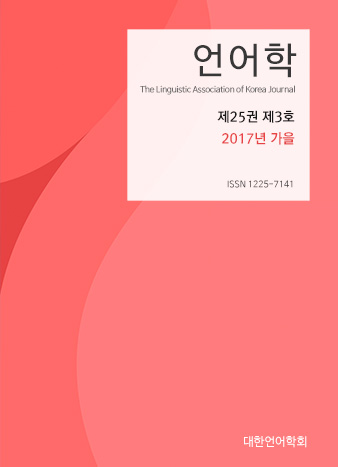대한언어학회 전자저널

25권 3호 (2017년 9월)
- 한국어와 카자흐어의 감정표현 관용구 비교연구
-
아이게림
Pages : 153-171
Abstract
Belyalova, Aigerim. (2017). A comparative study of emotional expression idiomatic phrases in Korean and Kazakh languages. The Linguistic Association of Korea Journal, 25(3), 153-171. Kazakh and Korean languages are typologically agglutinative languages and they are in the family of Altaic languages. So, systematically they have many syntactic and morphologic similarities. Based on these facts, the purpose of this study is to present the homogeneity and heterogeneity between the two languages through the comparison of Idiomatic Phrase which express emotions using human body parts. In this thesis after the reviewing previous research on Idiomatic Phrase they are categorized into five main emotional groups. They are joy, sadness, love, anger, and fear. An Idiomatic Phrase that uses a part of the human body describes not simply a body part, but also presents a variety of human emotions, actions, and lifestyles through it. I hope this study will be a starting point for many further studies of Idiomatic Phrase of the Korean and Kazakh languages.
Keywords
# 감정표현(Emotional Expression) # 신체어휘(Physical Vocabulary) # 관용구(Idiomatic Phrase) # 비교 연구(Comparative Study) # 카자흐어(Kazakh language) # 언어 유형론(linguistic typology)
References
- 김진식. (1996). 관용어와 속담의 특성 고찰(I)-상이점을 중심으로. 개신어문연구 13집, 17-41.
- 국립국어연구원. (2008). 표준국어대사전. 서울: 두산동아.
- 국립국제교육원. (2017). 제1차 특수외국어교육 진흥 5개년(2017-2021) 기본계획.
- 김향숙. (2003). 한국어 감정표현 관용어 연구. 서울: 한국문화사.
- 남혜현. (2007). 신체화에 따른 의미확장 연구. 노어노문학, 19(3), 3-28.
- 누르갈리에바. (2008). 한국어와 러시아어 관용구의 비교연구. 석사학위논문. 대구대학교.
- 루린지예. (2016). 한·중 감정 표현 오관(五官) 관용어 의미 대조 연구. 석사학위논문. 경희대학교.
- 문금현. (1999). 국어의 관용 표현 연구. 태학사.
- 박영준·최경봉. (1996). 관용어 사전, 파주시: 태학사.
- 성광수. (1995). 국어 관용표현의 구조와 의미적 특성. 성곡논총, 26, 849-890.
- 송수영. (2016). 카자흐인 학습자를 위한 한국어 단위명사 교육 방안 연구. 석사학위논문. 경희사이버대학교.
- 심재기. (1986). 한국어 관용표현의 화용론적 연구. 관악어문연구, 11, 27-54.
- 양영희. (1995). 관용표현의 의미 구현 양상. 국어학, 26, 171-200.
- 연세대학교 언어정보개발연구원. (1998). 연세한국어사전, 서울: 두산동아.
- 응웬 티 꾸잉 안. (2013). 한·베 감정적 신체 관용 표현 연구. 석사학위논문. 경희대학교.
- 이진금. (2010). 독일어 관용어 이해와 학습에 대한 연구: 독ㆍ한 신체어 관용어의 예를 중심으로. 석사학위논문. 성균관대학교.
- 임지룡. (1999). 감정의 생리적 반응에 대한 언어화 양상. 담화와 인지, 6(02), 89-117.
- 임지룡. (2005). ‘사랑’의 개념화 양상. 어문학, 87, 201-233.
- 장세경·장경희. (1994). 국어 관용어에 관한 연구: 정서 표현을 중심으로. 동아시아문화연구, 25(0), 295-318.
- 장훼이메이, (2014). 한국 드라마를 활용한 감정표현 관용어 교육방안 연구: 기쁨과 슬픔 감정을 중심으로. 석사학위논문. 경희대학교.
- 정다미. (2016). 한국어 보조용언의 습득 양상 연구: 카자흐인 학습자를 중심으로. 석사학위논문. 한국외국어대학교.
- 정성미. (2008). 신체어 감정 관용표현의 서술어 의미 연구: 긴장과 분노 감정 표현을 중심으로. 한국어의미학, 27, 243-265.
- 주경미. (2006). 신소설에 나타난 신체어 관련 관용 표현 연구: ‘손, 눈, 입, 코, 귀’를 중심으로. 한국언어문학, 58, 25-51.
- 최경봉. (1992). 국어 관용어 연구. 석사학위논문. 고려대학교.
- 퓨렙 어덩치맥, (2008). 한ㆍ몽 감정 관련 관용 표현의 의미와 번역 연구 : 신체어를 중심으로. 석사학위논문. 경기대학교.
- 한만춘. (2006). 한국어와 러시아어 관용구의 비교연구: 감정표현 관용구를 중심으로. 노어노문학, 18(1), 87-120 .
- 한정한. (2010). 관용구의 문법범주. 어문논법, 61(61), 315-349.
- Abagan A. 외 1인. (2013). National Specific of Idioms in Kazakh and Korean Languages. International Scholarly and Scientific Research & Innovation, 7(2), 472-475.
- Abagan A. 외 3인 (2017). Cultural connotation of Korean and Kazakh idioms. G-Global, 25(1). 15-21.
- Batyrkhanova, G. (2013). 한국어와 카자흐어의 격표지 대조분석. 석사학위논문. 이화여자대학교.
- Belyalova, A. (2015). 한국어와 카자흐어의 관용어 대조 연구: 신체어휘 관용어에 나타나는 감정 표현을 중심으로. 석사학위논문. 성균관대학교.
- Johnson-Laird, P.N., & Oatley, K. (1989). The language of emotion: An analysis of a semantic field. Cognition and Emotion, 3(4), 201-223.
- Kadyrova, A. (2014). 한국어 보조사와 카자흐어 조사 대비 연구: ‘-도, -만, -라도/da(dе, ta, te), qana, tek, -aq'을 중심으로. 석사학위논문. 아주대학교.
- Kaidar A. (2003). Kazakh-Russian Phraseological Dictionary. Astana: Bilge.
- Kenesbayev, I. (1977). Vocabulary of Kazakh Phraseologies. Almaty: Arys.
- Smagulova G. (2014). Verbal communication culture of the modern youth: Based on the study of Kazakh phraseological units. International Informational and Analytical Journal ≪Crede Experto: transport, society, education, language≫, 02(09), 50-61.